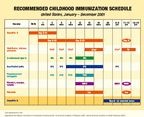Drug Therapy: What's new in the 2001 immunization schedule
The biggest change in this year's schedule is the addition of the seven-valent pneumococcal conjugate vaccine.
Special Report
What's new in the 2001 immunization schedule
The biggest change in this year's schedule is the addition of the seven-valent pneumococcal conjugate vaccine.
At the end of every year, the Advisory Committee on Immunization Practices (ACIP) of the Centers for Disease Control and Prevention (CDC), the American Academy of Pediatrics, and the American Academy of Family Physicians release the schedule of recommended childhood immunizations for the following year. The schedule for 2001 differs from last year's in three ways:
- The new seven-valent pneumococcal conjugate vaccine (Prevnar) was added to the schedule. It is the first pneumococcal vaccine approved for use in children younger than 2 years.
- The three doses of hepatitis B vaccine (HepB) are now numbered to avoid confusion.
- The word "inactivated" has been added to identification of the polio vaccine. An all-IPV schedule was first recommended last year for routine childhood polio vaccination.
- The schedule has been extended to cover 14- to 18-year-olds instead of ending with 14- to 16-year-olds.
The complete schedule appears on the facing page. Bars indicate the range of recommended ages for each dose. Any dose not given at the recommended age should be given at a subsequent visit. Ovals indicate vaccines to be given if recommended doses were missed or were given earlier than the recommended minimum age. Combination vaccines may be used whenever any components of the combination are indicated and its other components are not contraindicated. The following qualifications apply to this year's schedule:
Hepatitis B. Infants born to HbsAg-negative mothers should receive the first dose of hepatitis B vaccine by 2 months of age. The second dose should be administered at least one month after the first dose. The third dose should be administered at least four months after the first dose and at least two months after the second dose but not before the infant is 6 months of age. Infants born to HbsAg-positive mothers should receive vaccine and 0.5 mL hepatitis B immune globulin (HBIG) within 12 hours of birth at separate sites. The second dose is recommended at 1 to 2 months of age and third dose at 6 months of age. Infants born to mothers whose HbsAg status is unknown should receive vaccine within 12 hours of birth, and maternal blood should be tested. If the test is positive, the infant should receive HBIG as soon as possible and no later than 1 week of age. Unimmunized children and adolescents should begin the series during any visit. Immunization is especially important for children who were born in areas of the world where hepatitis B virus infection is moderately or highly endemic or whose parents were born in these areas.
DTaP. The fourth dose may be administered as early as 12 months of age, provided six months have elapsed since the third dose and the child is unlikely to return at age 15 to 18 months. Tetanus and diphtheria toxoids (Td) are recommended at 11 to 12 years of age if at least five years have elapsed since the last dose of DTP, DTaP, or DT. Subsequent routine Td boosters are recommended every 10 years.
Haemophilus influenzae type b (Hib) conjugate vaccines. If Pedvax or ComVax (PRP-OMP) is administered at 2 and 4 months of age, a dose at 6 months is not required. DTaP/Hib combination products should not be used for primary immunization in infants at 2, 4, or 6 months of age unless FDA approved for these ages.
Polio. An all IPV schedule is recommended. All children should receive four doses of IPV at 2 months, 4 months, 6 to 18 months, and 4 to 6 years of age. Oral polio vaccine (OPV) should be used only in selected circumstances: during mass vaccination campaigns to control outbreaks of paralytic polio, in unvaccinated children who will be traveling in less than four weeks to areas where polio is endemic or epidemic, and in children of parents who do not accept the recommended number of vaccine injections. Children in this last group may receive OPV only for the third or fourth dose or both and only after the health-care provider has discussed the risk for vaccine-associated paralytic polio with caregivers.

PCV. The seven-valent conjugate pneumococcal vaccine is recommended for all children 2 to 23 months of age. It also is recommended for certain children 24 to 59 months of age at increased risk for pneumococcal disease. This group includes children with sickle cell disease, HIV infection, other immunocompromising conditions, or chronic medical conditions.
MMR. The second dose is recommended routinely at 4 to 6 years of age but may be administered during any visit, provided at least four weeks have elapsed since the first dose and both doses are administered after 12 months of age. Children who have not previously received the second dose should complete the schedule by the 11- to 12-year-old visit.
Varicella. The vaccine is recommended at any visit after the first birthday for children who lack a reliable history of chickenpox. Susceptible individuals 13 years of age or older should receive two doses at least four weeks apart.
Hepatitis A. The darker shading of the bar indicates that the vaccination is recommended in selected states, namely AK, AZ, CA, ID, NM, NV, OK, OR, SD, UT, and WA. Routine immunization also should be considered for children in AR, CO, MO, MT, TX, and WY. Clinicians should consult their local public health authority for specific recommendations.
For additional information about these vaccines, clinicians can consult the National Immunization Program Home Page at www.cdc.gov/nip or call the National Immunization Hotline at 800-232-2522 (English) or 800-232-0233 (Spanish).
What's new in the 2001 immunization schedule. Contemporary Pediatrics 2001;1:22.